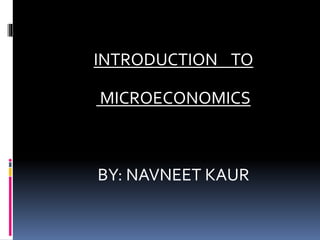
Micro and macroeconomics
- 2. What is microeconomics? Microeconomics is the branch of economics that considers the behavior of decision takers within the economy, such as individuals, households and firms.The word ‘firm’ is used generically to refer to all types of business. Microeconomics contrasts with the study of macroeconomics, which considers the economy as a whole.
- 3. The platform on which microeconomic thought is built lies at the very heart of economic thinking – namely, how decision takers choose between scarce resources that have alternative uses. Consumers demand goods and services and producers offer these for sale, but nobody can take everything they want from the economic system. SCARCITY,CHOICE AND OPPORTUNITY COST
- 4. Producers also have to decide how much to produce and for whom. A simple answer to the first question might be: ‘As much as possible of course, using all the resources we can’. However, classical economists teach us that if we combine all of the factors of production – land, labour, capital and the entrepreneur – in different ways, we can get some surprising results. One of the most famous of these is confirmed by the law of diminishing returns.
- 5. The price mechanism Much of the study of microeconomics is devoted to analysis of how prices are determined in markets. A market is any system through which producers and consumers come together. In early subsistence economies, markets were usually physical locations where people would come together to trade.
- 6. Producers and consumers generate forces that we call supply and demand respectively, and it is their interaction within the market that creates the price mechanism. This mechanism was once famously described as the ‘invisible hand’ that guides the actions of producers and consumers.
- 7. DEMAND Demand is created by the needs of consumers, and the nature of demand owes much to the underpinning worth that consumers perceive the good or service to have. We all need necessities, such as basic foodstuffs, but other products may be highly sought after by some and regarded as worthless by others.
- 8. The level of demand for a good or service is determined by several factors, including: the price of the good or service prices of other goods and services, especially substitutes and complements income tastes and preferences expectations.
- 9. The most common way of analyzing demand is to consider the relationship between quantity demanded and price. Assuming that people behave rationally, and that other determinants of demand are constant, the quantity demanded has an inverse relationship with price.
- 10. Therefore, if price increases, the quantity demanded falls, and vice versa. Figure 1 portrays the conventional demand curve.
- 11. Figure 1: Demand curve
- 12. A change in price will cause a movement along the curve.When the price increases, the quantity demanded will reduce. This happens with most types of goods, with some bizarre exceptions. Demand for what are known as ‘Giffen goods’ actually rises with an increase in the price for such goods. For example, when the price of rice increases in some regions of China, more rice will be purchased, as there is not enough income left over to some consumers to purchase higher value food items.
- 13. Supply Supply refers to the quantity of goods and services offered to the market by producers. Just as we can map the relationship between quantity demanded and price, we can also consider the relationship between quantity supplied and price. Generally, suppliers will be prepared to produce more goods and services the higher the price they can obtain.
- 14. Therefore, the supply curve – when holding other influences constant – will slope upwards from left to right, as illustrated in Figure 2.
- 15. Figure 2: Supply curve
- 16. The determinants of supply are: price prices of other goods and services relative revenues and costs of making the good or service the objectives of producers and their future expectations technology.
- 17. Elasticity The concept of elasticity is concerned with the responsiveness of quantity demanded or quantity supplied to a change in price. If a small change in price brings about a massive change in quantity demanded, the price elasticity of demand is said to be highly elastic. Conversely, if a change in price has little or no effect on the quantity demanded, the demand is said to be highly inelastic
- 18. In addition to price elasticity, there are similar concepts of relevance to your study: Income elasticity is the responsiveness of quantity demanded or supplied to a change in income. Cross elasticity is the responsiveness of quantity demanded or supplied of good X to a change in price of goodY.
- 19. Equilibrium Assuming all determinants of supply and demand are to be constant except price, a firm will produce where the supply curve intersects the demand curve. By definition, this is the point at which the quantity supplied equals the quantity demanded (Figure 3).
- 21. If the price is set above the equilibrium price, this will result in the quantity supplied exceeding the quantity demanded. Therefore, in order to clear its inventory, the company will need to reduce its price.
- 22. Conversely, if the price is set below the equilibrium price, this will result in an excess demand situation, and the only way to eliminate this is to increase the price.